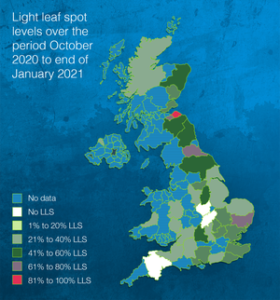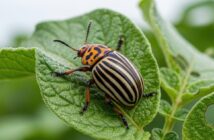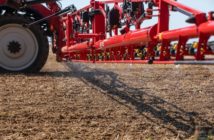Leaf samples sent to Bayer’s SpotCheck light leaf spot identification service are showing high levels of disease across the country, prompting warnings to growers to be on the alert for infection and to apply a fungicide as soon as symptoms are observed.
Ella Crawford, commercial technical manager at Bayer, says, “Throughout late autumn and into the early part of 2021 we were seeing evidence of light leaf spot at relatively high levels on the leaf samples from susceptible varieties, after incubation.
“During January, varying levels of disease were reported using the SpotCheck service, with 68% of samples showing positive signs, despite the colder weather. And, even though the cold weather continued into February for much of the country, mid-month results for February show very high levels of disease, with nearly 98% of samples showing positive light leaf spot infection after incubation.”
While light leaf spot has historically been a disease of the north, it is now widespread, with infection found regularly in southern parts of the UK. A move to earlier drilling may be one of the causes in this increase in infection, with growers trying to get crops established quickly, to grow away from pest pressure.
Light leaf spot can develop between 4 and 16°C, with rainfall and higher temperatures causing infection to spread more readily. And, while the recent cold snap may have supressed infection and disease expression for a while, any latent infection present in the leaf is more likely to develop as we move into early spring.

SpotCheck October 2020 to January 2021
Philip Walker, plant pathologist at ADAS, who runs the SpotCheck tests, says, “There is always variation year on year with light leaf spot infection levels, but we are roughly on-par with last year when we saw high infection levels in samples as we came out of winter. It’s fair to say that all fields are now at risk, with infected samples received from farms across the UK.
“Temperature and rainfall patterns as we move into spring will determine the risk of disease,” explains Philip. “Last year, although we came out of winter with relatively high disease infection, the dry and hot spring prevented the disease from spreading up the plant once we hit stem extension at GS31-39. This meant that light leaf spot didn’t reach the upper leaves or the pods.
“Light leaf spot spores are readily spread by rain splash, so if we get a more traditional warm and wet spring this season, growers should be aware that infection levels are likely to increase.”
Although there isn’t a threshold of disease incidence at which to spray for light leaf spot, there is a threshold at which growers can expect to see a yield loss. When plants are at early stem extension, growers can expect to lose around a third of yield potential if the crop is fully infected, although it only takes as much as 15% of plants infected with light leaf spot to see a 5% yield loss.
Weekly crop walking should include sampling of leaves and checking for signs of disease. These look like tiny grains of sugar on the leaf surface. They can be difficult to spot, so growers can choose to use Bayer’s SpotCheck service to help them justify any fungicide decisions.
“It doesn’t take a lot of infection at stem extension to result in significant yield loss,” says Ella. “So, it is important that fungicides are applied at the first signs of the disease. This is still the case where autumn applications were made, as these will now be running out of steam and a second application will provide ongoing protection. Proline (prothioconazole) provides robust protection against light leaf spot, and has wide tank mix compatibility to help with spring workloads.
Growers wishing to use the SpotCheck service should request a sample pack from ADAS Boxworth, collect 30-35 leaves from a single field in a ‘W’ pattern, complete the assessment form and send the leaves to ADAS. The results will be emailed within five working days.
For more on the SpotCheck initiative visit: cropscience.bayer.co.uk/spotcheck




